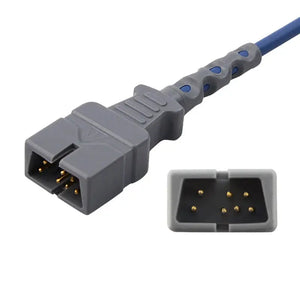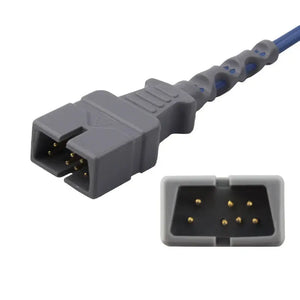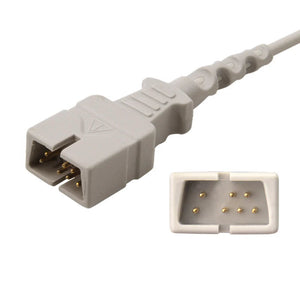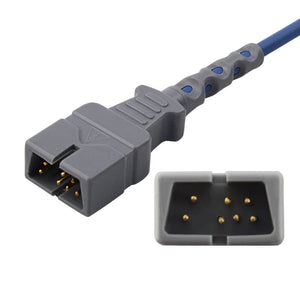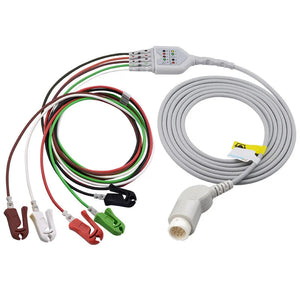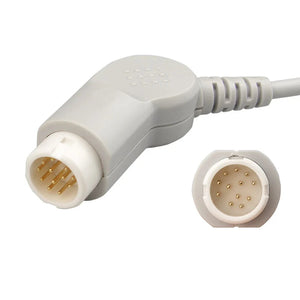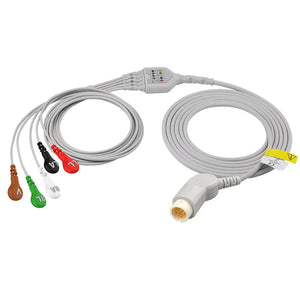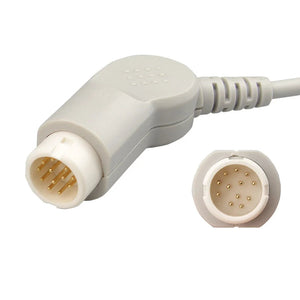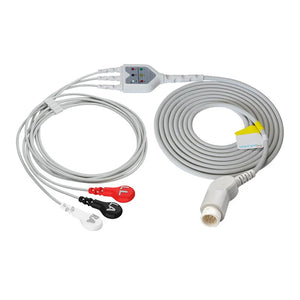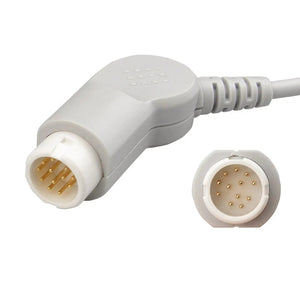If you avoid distractions and use a systematic method, you will catch details that many beginners miss, like rhythm changes or conduction issues. Reliable tools such as a 12 Lead ECG Trunk Cable and GE Healthcare Compatible Disposable Electrode Pads help you get accurate readings, especially in busy hospital settings. Our company supports over 2,000 hospitals in 120 countries, ensuring every product meets strict quality standards. You will find these instructions easy to follow, with no confusing terms. You will also learn how do you count heart rate on ecg in simple steps.
Key Takeaways
- Understand the basics of an EKG. It records your heart's electrical activity and helps diagnose heart issues.
- Use high-quality equipment, like the 12-Lead ECG Trunk Cable, for accurate EKG readings.
- Learn the normal EKG waveforms: P wave, QRS complex, T wave, and their significance in heart function.
- Check the heart rhythm systematically. Look for regularity, rate, and the relationship between P waves and QRS complexes.
- Measure key intervals: PR interval, QRS duration, and QT interval to assess heart health.
- Practice calculating heart rate using methods like the Big Box Method and the 6-Second Method for accuracy.
- Avoid common mistakes by ensuring proper electrode placement and checking machine calibration before readings.
- Regular practice with sample EKGs builds confidence and improves your ability to spot abnormalities.
EKG Basics
What Is an EKG
An electrocardiogram, or EKG, is a simple test that records your heart’s electrical activity. You do not feel pain during this test. Healthcare providers place small electrodes on your skin. These electrodes pick up the electrical signals that make your heart beat. The EKG machine then draws these signals as waves on a graph. You can have this test while you rest or even while you exercise. The EKG helps you and your doctor see how your heart works in real time.
Tip: Using a high-quality cable, such as the 12-Lead ECG Trunk Cable (GE Marquette Compatible), ensures you get clear and accurate EKG readings. This cable works with many GE and Marquette systems and supports both adults and children.
You can use an EKG to check for heart rhythm problems, monitor ongoing treatment, or look for signs of heart disease. The test is quick, noninvasive, and cost-effective. You can repeat it as needed to track changes in your heart’s health.
Healthcare providers use EKGs to:
- Diagnose heart rhythm issues.
- Monitor how well treatments are working.
- Record the timing and strength of your heart’s electrical impulses.
Why EKGs Matter
You should know when to get an EKG. Doctors often order this test if you have chest pain, shortness of breath, or other heart-related symptoms. Sometimes, you need an EKG before surgery or as part of a routine checkup if you have risk factors for heart disease. The table below shows common reasons for ordering an EKG:
| Clinical Indication | Description |
|---|---|
| Cardiopulmonary complaints | EKG is part of the admission evaluation for these symptoms. |
| Pre-procedure cardiac evaluation | Needed before surgeries or procedures that stress the heart. |
| No cardiopulmonary complaints | Not usually needed unless your doctor says otherwise. |
| Case-by-case EKG requests | Your provider may order an EKG based on your unique health situation. |
You can use EKGs to detect heart problems early. This allows you and your doctor to act quickly and prevent serious issues. Regular EKGs help you track your heart’s health over time.
Normal EKG Waves
When you look at an EKG, you see a series of waves. Each wave tells you something about how your heart works. You should learn what normal waves look like so you can spot problems early.
- P wave: Shows atrial activation. It usually lasts less than 0.12 seconds and is not very tall.
- QRS complex: Represents ventricular activation. It is sharp and narrow, lasting less than 0.10 seconds.
- ST segment: Connects the QRS complex and T wave. It should be smooth and blend into the T wave.
- T wave: Follows the QRS complex. It is usually upright in most leads.
- U wave: Sometimes appears after the T wave. It is less common but can be normal.

| Waveform | Characteristics |
|---|---|
| P Wave | Duration < 0.12 sec, Amplitude < 2.5 mm, Axis: 0° to +75°, may be notched or biphasic. |
| QRS Complex | Duration ≤ 0.10 sec, variable amplitude, normal axis range (+90° to -30°), small q-waves present. |
| ST Segment | Usually smooth and continuous with T wave, normal elevation is concave upward. |
| T Wave | Usually in the same direction as QRS, upright in leads I, II, V3-6, inverted in lead aVR. |
| U Wave | Often neglected, may be present following the T wave. |
Note: Always use a systematic approach when reading an EKG. Start by checking the waves in order. This helps you avoid missing important details.
You can master EKG basics by practicing with real examples and using reliable equipment. This foundation will help you read EKGs with confidence.
EKG Components
P Wave
When you look at an EKG, the first small bump you see is the P wave. This wave shows the electrical activity that starts in the upper chambers of your heart, called the atria. The P wave marks the beginning of each heartbeat. You can think of it as the signal that tells your heart to start pumping blood from the atria into the ventricles. If the P wave looks normal, your heart’s upper chambers are working as they should.
Tip: Always check the P wave first. A clear, regular P wave means your heart’s rhythm starts correctly.
The P wave is important because it shows atrial depolarization. This process triggers atrial contraction, which pushes blood into the ventricles. If you see changes in the P wave, such as it being too tall or missing, you should consider possible atrial problems.

PR Interval
Next, you should look at the PR interval. This is the flat line between the start of the P wave and the beginning of the QRS complex. The PR interval tells you how long it takes for the electrical signal to travel from the atria to the ventricles. You can measure this interval to check if the signal moves at a normal speed.
The normal PR interval ranges from 0.12 to 0.20 seconds.
If the PR interval is longer than 0.20 seconds, you may have a first-degree heart block. This can happen if the AV node slows down the signal.
Causes of a long PR interval include:
- Fibrosis of the AV node
- High vagal tone
- Some medications (like beta-blockers)
- Low potassium levels
- Acute rheumatic fever
- Carditis from Lyme disease
If the PR interval is shorter than 0.12 seconds, you may have a pre-excitation syndrome or a junctional arrhythmia.
You should always measure the PR interval when you read an EKG. This step helps you spot problems with the heart’s electrical conduction.
QRS Complex
The QRS complex is the next big spike you see on the EKG. This part shows the electrical activity in the ventricles, which are the lower chambers of your heart. The QRS complex marks the moment your heart pumps blood out to your body.
| Component --- | Description --- |
| QRS complex --- | Shows ventricular depolarization. This is when the ventricles contract and send blood to the lungs and the rest of your body. |
The QRS complex is usually sharp and narrow. If it looks wide or strange, you may have a problem with how your heart’s lower chambers conduct electricity. The duration of the QRS complex tells you how quickly the ventricles respond. A normal QRS complex means your heart pumps efficiently.
Note: Using a reliable cable, such as the 12-Lead ECG Trunk Cable (GE Marquette Compatible), helps you get a clear QRS complex. This cable works with many ECG systems and supports both adults and children. You can trust its quality and compatibility for accurate readings.
You should always check the QRS complex for shape and width. This step helps you find issues like bundle branch blocks or ventricular arrhythmias.
You can use the table below to review the main EKG components and what they show about your heart:
| Component --- | Description --- |
| P wave --- | Shows atrial depolarization (upper chambers start the heartbeat). |
| PR interval --- | Measures time from atrial to ventricular depolarization (signal travel time). |
| QRS complex --- | Shows ventricular depolarization (lower chambers contract). |
By following these steps, you can read each part of the EKG and understand what is happening in your heart. Practice with real EKGs and use quality equipment to improve your skills.
T Wave
When you read an EKG, you will notice the T wave after the QRS complex. The T wave looks like a gentle hill or bump. It shows the electrical recovery of your heart’s ventricles after they contract. This process is called ventricular repolarization. You can think of the T wave as your heart’s way of resetting itself for the next beat.
You should always check the T wave’s shape, size, and direction. In most EKG leads, the T wave points upward. It usually appears smooth and rounded. If you see a T wave that is flat, inverted, or very tall, you may need to look for possible heart problems.
Tip: A normal T wave is upright in most leads and follows the QRS complex. If you see a T wave that looks different, take a closer look at the patient’s history and symptoms.
How to Identify the T Wave
- Find the QRS complex, which is the tall, sharp spike.
- Look right after the QRS complex for a smaller, rounded wave. This is the T wave.
- Check if the T wave is upright and smooth in leads I, II, and V3-V6.
- Compare the T wave’s height to the QRS complex. The T wave should be smaller.
You can use a high-quality cable, such as the 12-Lead ECG Trunk Cable, GE Marquette Compatible (SKU: VE006-BAI), to get a clear EKG tracing. This cable works with many GE and Marquette systems, supports both adults and children, and uses color coding for easy setup. You will find it reliable for both routine checks and urgent cases. The cable is latex-free, about 7 feet long, and comes with a 12-month warranty. If you want a dependable cable that “works like the OEM or your money back,” this is a smart choice.

Why the T Wave Matters
The T wave gives you important clues about your heart’s health. Abnormal T waves can signal problems such as low potassium, heart attacks, or effects from certain medications. Sometimes, changes in the T wave are the first sign of a serious heart condition.
Here is a table that shows why you should pay close attention to T wave changes:
| Evidence Description --- | Importance in Clinical Context --- |
| T wave abnormalities can indicate underlying cardiac pathology. --- | They serve as early markers for various cardiac conditions, crucial for risk stratification and prevention of sudden cardiac death (SCD). --- |
| Individuals with inverted T waves or abnormal QRS-T angles have a higher risk of SCD. --- | These changes can predict a two- to threefold increased risk of SCD, even after adjusting for conventional risk factors. --- |
| Minor ST-T abnormalities have been linked to reduced survival rates. --- | They can predict increased risk of SCD in the adult population, emphasizing the need for clinical evaluation. --- |
You should always note any T wave changes and report them to a healthcare provider. Early detection can help prevent serious complications.
Note: Practice reading T waves on different EKGs. The more you practice, the easier it becomes to spot normal and abnormal patterns.
By checking the T wave every time you read an EKG, you will improve your skills and help keep your patients safe.
Reading an EKG
Step 1: Paper Speed
You should always check the paper speed before you start reading an EKG. Most EKG machines use a standard paper speed of 25 millimeters per second (mm/s). This speed helps you measure time intervals and heart rate accurately. If the paper speed is different, your calculations may be wrong.
| Paper Speed (mm/s) | Small Square (1mm) | Large Square (5mm) |
|---|---|---|
| 25 | 0.04 seconds | 0.2 seconds |

You can find the paper speed printed at the bottom or top of the EKG strip. If you use a high-quality cable like the 12-Lead ECG Trunk Cable, GE Marquette Compatible (SKU: VE006-BAI), you get a clear tracing that makes it easier to see the grid and measure intervals. This cable works with many GE and Marquette systems, supports both adults and children, and uses color coding for easy setup.
Tip: Always confirm the paper speed before you start measuring anything on the EKG. This step prevents mistakes in heart rate and interval calculations.
Step 2: Rhythm Check
Next, you should check the heart rhythm. This step helps you find out if the heart beats regularly or irregularly. A systematic approach makes sure you do not miss important details.
Follow these steps to check the rhythm:
- Rate: Count the number of QRS complexes in a set time. A normal heart rate is 60-100 beats per minute. If the rate is higher, you may have tachycardia. If it is lower, you may have bradycardia.
- Pattern of QRS Complexes: Look at the spacing between QRS complexes. If the spacing is even, the rhythm is regular. If not, check if the irregularity follows a pattern.
- QRS Morphology: Check if the QRS complexes are narrow or wide. Narrow QRS complexes suggest the signal starts above the ventricles. Wide QRS complexes may mean a problem in the ventricles or abnormal conduction.
- P Waves: Look for P waves before each QRS complex. The presence or absence of P waves can help you identify conditions like atrial fibrillation.
- Relationship Between P Waves and QRS Complexes: Make sure each P wave is followed by a QRS complex. This step checks if the atria and ventricles work together.
- Onset and Termination: Notice if the rhythm starts or stops suddenly. Abrupt changes may suggest a re-entrant process.
- Response to Vagal Maneuvers: In some cases, doctors use vagal maneuvers to see how the rhythm responds. This step helps tell different types of tachycardia apart.
Note: Always use the same order when checking rhythm. This habit helps you avoid distractions and catch subtle changes.
Step 3: Wave Identification
You should now identify each wave on the EKG. This step helps you understand the heart’s electrical activity and spot any problems.
- Start with the P wave. This wave shows the upper chambers (atria) starting the heartbeat.
- Find the QRS complex. This sharp spike shows the lower chambers (ventricles) contracting.
- Look for the T wave. This wave comes after the QRS complex and shows the ventricles resetting for the next beat.
To get the best results, follow these best practices:
- Use high-quality electrodes and cables. The 12-Lead ECG Trunk Cable, GE Marquette Compatible (SKU: VE006-BAI), gives you a clear signal and reduces artifacts.
- Prepare the patient’s skin by cleaning it and placing electrodes in the correct spots. Good preparation lowers the chance of errors.
- Pay close attention to lead placement. Incorrect placement can change the way waves look and lead to mistakes.
Callout: A clear EKG tracing makes it easier to see each wave. Always check your equipment and patient preparation before starting.
Here is a table that shows the recommended steps for reading an EKG, based on cardiology guidelines:
| Step | Description |
|---|---|
| Rhythm | Is the rhythm regular or irregular? (relationship between P and QRS) |
| Rate | Is it fast or slow? (tachycardia or bradycardia) |
| Ischemia or Infarction | Look for ST changes and T-wave changes |
| Axis | Check for left or right axis deviation |
| Morphology | Assess for chamber enlargement or hypertrophy |
| P-QRS-T | Evaluate intervals and wave progression |
By following these steps, you can read an EKG in a systematic way. Practice each step until it becomes a habit. This approach helps you catch important details and improves your confidence in EKG interpretation.
Step 4: Interval Measurement
You need to measure key intervals on every EKG. These intervals help you understand how electricity moves through the heart. Accurate measurement can reveal hidden problems, so always use a systematic approach.
Start by checking the following intervals:
- PR Interval: This measures the time from the start of the P wave to the start of the QRS complex. It shows how long the electrical signal takes to travel from the atria to the ventricles.
- QRS Duration: This measures how long the ventricles take to contract. You find it by measuring the width of the QRS complex.
- QT Interval: This measures the time from the start of the QRS complex to the end of the T wave. It shows how long the ventricles take to contract and then recover.
You can use the small squares on the EKG paper to measure these intervals. Each small square equals 0.04 seconds. Count the number of small squares for each interval, then multiply by 0.04 to get the time in seconds.
Tip: Always check the paper speed before measuring. Most EKGs run at 25 mm/s, so each small square is 0.04 seconds.
Here is a table with normal ranges for each interval:
| Interval Type | Normal Range (msec) | Normal Range (sec) | Small Squares |
|---|---|---|---|
| PR Interval | 125–196 | 0.12–0.20 | 3–5 |
| QRS Duration | 69–103 | 0.08–0.12 | 2–3 |
| QT Interval (QTcB) | 365–468 | 0.35–0.43 | 9–11 |
If you see intervals outside these ranges, you should look for possible causes:
- A long PR interval may mean a first-degree heart block.
- A wide QRS complex can signal a bundle branch block or ventricular rhythm.
- A prolonged QT interval increases the risk of dangerous arrhythmias.
Note: Using a high-quality cable, like the 12-Lead ECG Trunk Cable, GE Marquette Compatible (SKU: VE006-BAI), helps you get clear tracings. This cable supports both adults and children, uses color coding for easy setup, and works with many GE and Marquette systems. You get reliable measurements every time.
Step 5: Abnormalities
After you measure the intervals, you need to look for abnormalities. These changes can point to heart problems that need quick attention.
Common EKG abnormalities include:
- Arrhythmias (irregular heartbeats)
- Ischemia (reduced blood flow to the heart)
- Enlarged or thickened heart muscle
- Signs of a previous heart attack
- Effects from medications
- Electrolyte imbalances (like low potassium)
- Structural changes in the heart
- Inflammation (such as pericarditis)
- Age or gender-related changes
- Other health conditions
T-wave abnormalities are the most common EKG finding. You often see them in people with heart problems. These changes can signal myocardial ischemia, which means the heart muscle does not get enough oxygen. If you see T-wave changes, you should consider the patient’s risk factors and symptoms. Studies show that people aged 40–49 with T-wave abnormalities have a much higher risk of serious heart events in the next five years.
Alert: Always report new or unexplained EKG changes to a healthcare provider. Early action can prevent complications.
You can also use the EKG to help diagnose inflammation, such as pericarditis. Early diagnosis and treatment lower the risk of recurrence and complications. Dynamic EKG changes help you and your team track how well treatment works.
When you use a reliable cable like the 12-Lead ECG Trunk Cable, GE Marquette Compatible (SKU: VE006-BAI), you get clear signals that make it easier to spot these abnormalities. This cable offers a 12-month warranty, works with many ECG systems, and saves you up to 50% compared to OEM prices. You can trust it for both routine checks and urgent cases.
Tip: Practice reading EKGs with different abnormalities. The more you practice, the faster you will spot important changes.
Heart Rate Calculation
You can calculate heart rate from an EKG in just a few minutes if you use the right method. Each method works best for certain types of rhythms. You should always start by checking that your EKG tracing is clear. Using a reliable cable, such as the 12-Lead ECG Trunk Cable, GE Marquette Compatible (SKU: VE006-BAI), helps you get accurate results. This cable supports both adults and children, uses color coding for easy setup, and works with many GE and Marquette systems.
Big Box Method
The Big Box Method is one of the fastest ways to estimate heart rate on an EKG. You use this method when the heart rhythm is regular.
How to use the Big Box Method:
- Find two consecutive R waves (the tall spikes in the QRS complexes).
- Count the number of large boxes (big squares) between these R waves.
- Divide 300 by the number of large boxes.
- For example, if there are 4 large boxes between R waves, the heart rate is 300 ÷ 4 = 75 beats per minute.
Tip: This method gives you a quick estimate. It works best when the rhythm is regular.
Here is a table comparing the accuracy and speed of common heart rate calculation methods:
| Method | Accuracy | Speed |
|---|---|---|
| Big Box Method | Less precise | Rapid approximation |
| Small Box Method | More precise | Moderate speed |
| 6 Second Method | More precise | Moderate speed |

You can use the Big Box Method to answer the question: how do you count heart rate on ecg when you need a fast answer? Just remember, this method is less precise than others, but it is very quick.

6-Second Method
The 6-Second Method works well for both regular and irregular rhythms. You use this method when the rhythm is not steady or when you want a more accurate count.
Follow these steps:
- Find a 6-second section on the EKG strip. Most EKG papers mark this with a line or a number at the bottom.
- Count the number of QRS complexes (R waves) in that 6-second section.
- Multiply that number by 10. This gives you the heart rate in beats per minute.
- For example, if you count 8 QRS complexes in 6 seconds, the heart rate is 8 × 10 = 80 beats per minute.
Note: If the rhythm is very irregular, you can use a longer strip, such as 15 seconds, and multiply the number of QRS complexes by 4.
This method helps you answer how do you count heart rate on ecg when the rhythm is not regular. It is also a good way to double-check your results from other methods.
Square Counting
Square Counting is another quick way to estimate heart rate, especially when you want to use the pattern of large boxes between R waves.
How to use Square Counting:
- Start at an R wave that falls on a thick line (large box).
- Count each large box until the next R wave. Use this sequence to estimate the heart rate:
- 1st box: 300
- 2nd box: 150
- 3rd box: 100
- 4th box: 75
- 5th box: 60
- 6th box: 50
- 7th box: 43
- 8th box: 37
If the next R wave lands between two thick lines, take the average of the two numbers. For example, if it falls between 75 and 60, the heart rate is about 67 beats per minute.
Callout: Square Counting is fast and easy. You can use it to answer how do you count heart rate on ecg during emergencies or when you need a quick check.
You should always use a clear EKG tracing for these methods. The 12-Lead ECG Trunk Cable, GE Marquette Compatible (SKU: VE006-BAI), helps you get the best results. It is latex-free, about 7 feet long, and comes with a 12-month warranty. You can use it with many GE and Marquette systems, and it offers up to 50% cost savings compared to OEM cables.
Summary of Heart Rate Calculation Methods:
- Use the Big Box Method for quick estimates with regular rhythms.
- Use the 6-Second Method for irregular rhythms or more accuracy.
- Use Square Counting for a fast, visual approach.
Practice these methods often. You will become confident in how do you count heart rate on ecg in any situation.
How Do You Count Heart Rate on ECG
You can count heart rate on ECG quickly if you follow a few simple steps. You do not need advanced math or special training. You only need a clear ECG tracing and a systematic approach. Many healthcare professionals use these steps every day. You can use them at home, in a clinic, or in a hospital.
Step-by-Step Guide:
-
Check the Paper Speed:
Most ECG machines print at 25 mm per second. You can find this information at the bottom or top of the ECG strip. Always confirm the paper speed before you start. -
Find the R Waves:
Look for the tall spikes on the ECG tracing. These are called R waves. You will use them to measure the heart rate. -
Choose Your Method:
You can use the Big Box Method, 6-Second Method, or Square Counting. Each method works best for different rhythms.
For regular rhythms, use the Big Box Method or Square Counting.
For irregular rhythms, use the 6-Second Method. -
Count the Boxes or Complexes:
For the Big Box Method, count the large boxes between two R waves. Divide 300 by this number.
For the 6-Second Method, count the number of R waves in a 6-second strip. Multiply by 10.
For Square Counting, use the sequence (300, 150, 100, 75, 60, 50) to estimate the rate based on box spacing. -
Double-Check Your Result:
If you get an unusual number, repeat the process. You can try a different method for confirmation.
Tip: You get the most accurate results when you use high-quality equipment. The 12-Lead ECG Trunk Cable, GE Marquette Compatible (SKU: VE006-BAI), gives you a clear tracing. This cable works with many GE and Marquette systems. It supports both adults and children. You get a 12-month warranty and save up to 50% compared to OEM cables. You can buy it for US$88 (sale price) and use it with confidence.

Common Mistakes to Avoid:
- Do not count waves that are unclear or have artifacts.
- Do not forget to check the paper speed.
- Do not use a damaged or incompatible cable.
Quick Reference Table:
| Method --- | Best For --- | Steps --- | Example --- |
|---|---|---|---|
| Big Box Method --- | Regular rhythm --- | Count large boxes between R waves, divide 300 by number --- | 4 boxes: 300 ÷ 4 = 75 bpm --- |
| 6-Second Method --- | Irregular rhythm --- | Count R waves in 6 seconds, multiply by 10 --- | 8 R waves: 8 × 10 = 80 bpm --- |
| Square Counting --- | Fast estimate --- | Use box sequence (300, 150, 100, etc.) --- | R wave on 3rd box: 100 bpm --- |
You may ask, how do you count heart rate on ecg if the tracing is messy or the rhythm changes? You should always use the clearest part of the strip and repeat your measurement. You can also use a reliable cable like the 12-Lead ECG Trunk Cable, GE Marquette Compatible, to reduce noise and get a better signal.
Note: Practice these steps often. You will become faster and more confident. You will know how do you count heart rate on ecg in any situation.
Common Mistakes
When you read an EKG, you want to avoid common mistakes that can lead to wrong conclusions. By learning about these errors, you can improve your accuracy and confidence.
Misreading Waves
You may misread EKG waves if you do not pay close attention to electrode placement or if you overlook artifacts. Small mistakes in placing electrodes can change the appearance of the waves. For example, if you place the V1 or V2 lead too high, you might see changes in the P, R, or T waves. Swapping electrodes or moving them vertically or horizontally can also cause confusion. Artifacts, such as muscle tremors or loose cables, may look like dangerous rhythms but are not real heart problems.
Here is a table showing frequent mistakes with EKG waves:
| Type of Error | Description |
|---|---|
| Vertical Displacement | Electrodes are placed too high, often toward the head. |
| Horizontal Displacement | Electrodes are moved sideways from their correct spots. |
| Interchange of Electrodes | Electrodes are swapped from their assigned positions. |
| High Placement of V1 and V2 | Leads placed too high can change P, R, and T waves. |
| Artifacts in Recordings | Noise or movement can mimic abnormal rhythms, leading to misdiagnosis. |
Tip: Always double-check electrode placement and use a high-quality cable, such as the 12-Lead ECG Trunk Cable, GE Marquette Compatible (SKU: VE006-BAI). This cable’s color coding and secure connectors help you avoid placement errors and reduce artifacts.
Ignoring Calibration
You must check the calibration of your EKG machine before every reading. If the calibration is off, the EKG may show false results. This can lead to missed or incorrect diagnoses. Proper calibration ensures that the measurements you see match the true heart activity. Regular calibration also prevents errors from equipment drift or malfunction, which keeps your patients safe.
- Improper calibration can cause inaccurate readings and misdiagnosis.
- Accurate calibration lets you trust the EKG results.
- Regular checks prevent problems from equipment wear or faults.
Alert: Before you start, confirm that your EKG machine is calibrated. Using reliable accessories, like the 12-Lead ECG Trunk Cable (SKU: VE006-BAI), helps maintain signal quality and supports accurate readings.
Rhythm Confusion
You may find it hard to interpret heart rhythms if you do not know what causes abnormal patterns. Many factors can confuse rhythm interpretation. Irregular heart rates, changes in heart structure, or enlarged heart size can all affect the EKG. Electrolyte imbalances, medication side effects, high blood pressure, poor blood supply, and heart attacks can also change the rhythm.
Here is a table of common causes of rhythm confusion:
| Cause | Description |
|---|---|
| Irregularities in heart rate | Makes it hard to identify the rhythm pattern. |
| Structural abnormalities | Changes in heart shape or size disrupt electrical signals. |
| Enlarged heart size | Alters normal pathways, leading to abnormal rhythms. |
| Electrolyte imbalances | Affects the heart’s electrical activity, causing unusual EKG patterns. |
| Medication side effects | Some drugs change heart rhythm, making EKGs harder to read. |
| High blood pressure | Increases the chance of abnormal EKG results. |
| Poor blood supply (ischemia) | Reduces oxygen to the heart, causing rhythm changes. |
| Heart attacks | Damaged tissue disrupts normal conduction, leading to abnormal readings. |
Note: If you see a rhythm that does not make sense, review the patient’s history and check for these causes. Practice with different EKGs and use dependable equipment to build your skills.
By staying alert to these common mistakes, you can read EKGs more accurately and avoid costly errors. Reliable tools, such as the 12-Lead ECG Trunk Cable, GE Marquette Compatible, support your efforts by providing clear, consistent signals every time.
Practice and Support
Sample EKGs
You can improve your EKG reading skills by practicing with sample EKGs. Repetition helps you remember patterns and spot changes faster. When you review different tracings, you build confidence and accuracy. Many educators use workshop methods and spaced repetition to help students master EKG interpretation. You benefit from seeing a variety of cases and learning from your mistakes.
- Workshop-style practice outperforms traditional study methods.
- Learning by repetition and reviewing mistakes boosts memory retention.
- Spaced repetition and retrieval practice help you remember key features.
- Reverse pedagogy, where you try to interpret before seeing the answer, strengthens your skills.
You can find sample EKGs in textbooks, online resources, and training modules. Practicing with high-quality equipment, such as the 12-Lead ECG Trunk Cable, GE Marquette Compatible (SKU: VE006-BAI), ensures you see clear tracings. This cable works with many GE and Marquette systems, supports both adults and children, and uses color coding for easy setup. It is latex-free, about 7 feet long, and comes with a 12-month warranty. You can purchase it for US$88, making it a reliable and affordable choice for both learning and clinical use.
Tip: Practice with real EKGs and trusted accessories to build your skills and confidence.
Progress Tracking
You can track your progress in EKG interpretation using several effective methods. These tools help you see your strengths and areas for improvement. Many learners use feedback and structured programs to reach expert-level performance.
| Method | Description |
|---|---|
| Eye-Tracking Feedback | Visualizes your gaze patterns compared to experts, helping you focus on critical EKG areas. |
| Structured Training Programs | Develop targeted visual strategies to reduce mental effort and speed up interpretation. |
| Web-Based Learning Interventions | Offer self-directed learning and skill-building for all healthcare professionals. |
| Method | Description |
|---|---|
| Mixed Learning Methods | Combine stress management and simulations to help you adapt to real-world demands. |
| Gradual Complexity Simulations | Use step-by-step challenges to build expert-like performance and improve diagnostic accuracy. |
| Method | Description |
|---|---|
| Self-Directed Web-Based Interventions | Enhance EKG interpretation skills for a wide range of healthcare professionals. |
You can use these methods to set goals, measure your improvement, and stay motivated. Many online platforms offer quizzes, simulations, and feedback to help you learn at your own pace.
Note: Regular practice and progress tracking help you become more confident and accurate in EKG interpretation.
Company Strengths
You deserve support from a company with proven expertise and a global presence. Our company exports to over 120 countries and regions and connects with more than 2,000 hospitals and customers. We have focused on medical monitoring consumables for over 20 years. As the first listed company of patient monitor accessories in China, we lead the industry in quality and innovation.
Every product, including the 12-Lead ECG Trunk Cable, GE Marquette Compatible (SKU: VE006-BAI), passes a 100% quality test before shipment. We hold certifications that show our commitment to safety and quality:
| Certification | Description |
|---|---|
| CE | Meets EU safety, health, and environmental protection standards. |
| FDA | Passes rigorous U.S. medical device testing and approval. |
| GMP | Follows safe production practices. |
| ISO | Adheres to strict quality management processes. |

You can trust our products for both learning and clinical care. We continue to pass audits from top regulatory agencies, including China’s NMPA, the U.S. FDA, and Brazil’s ANVISA. Leading patient monitor companies assess our quality systems every year, and we always meet their standards.
Callout: When you choose our accessories, you get reliable performance, global support, and peace of mind for every EKG reading.
You can practice with confidence, knowing you have access to high-quality resources and expert support. Keep practicing, track your progress, and use trusted equipment to master EKG interpretation.
You can master EKG reading by following these steps:
- Check the R-R interval to determine heart rate.
- Assess if the rhythm is regular or irregular.
- Confirm normal P waves, QRS complexes, and intervals.
- Use methods like counting boxes or the 6-second strip.
- Regular practice builds your skills.
| Approach | Benefit |
|---|---|
| Systematic review | Faster, more accurate EKG reading |
| Repeated exposure | Stronger pattern recognition |
Choose trusted tools like the 12-Lead ECG Trunk Cable, GE Marquette Compatible (SKU: VE006-BAI), for reliable results.
Keep learning with resources such as ECGpedia and Core EM. You have the support and quality you need to succeed!
FAQ
How do you know if an EKG is normal?
You check for regular rhythm, normal P waves, QRS complexes, and T waves. You confirm intervals fall within standard ranges. You compare the tracing to reference examples. You use reliable equipment for clear results.
What is the easiest way to calculate heart rate on an EKG?
You count the large boxes between two R waves. You divide 300 by that number. You use the Big Box Method for regular rhythms. You get a quick estimate in seconds.
Can you use the 12-Lead ECG Trunk Cable for both adults and children?
You can use the 12-Lead ECG Trunk Cable, GE Marquette Compatible (SKU: VE006-BAI), for adults and pediatric patients. You get a 7-foot latex-free cable with color coding for easy setup.
What should you do if the EKG tracing looks unclear?
You check electrode placement and cable connections. You replace damaged accessories. You use high-quality cables like the GE Marquette Compatible model for better signal clarity.
How often should you calibrate your EKG machine?
You calibrate your EKG machine before each use. You follow manufacturer guidelines. You ensure accurate readings and avoid misdiagnosis.
What warranty comes with the 12-Lead ECG Trunk Cable?
You receive a 12-month warranty with the 12-Lead ECG Trunk Cable, GE Marquette Compatible. You get a money-back guarantee if it does not work like the OEM.
How do you avoid common EKG reading mistakes?
You use a systematic approach. You check paper speed, electrode placement, and calibration. You practice with sample EKGs. You use trusted accessories for reliable results.
Where can you buy the GE Marquette Compatible ECG Trunk Cable?
You can purchase the 12-Lead ECG Trunk Cable (SKU: VE006-BAI) for US$88. You get fast shipping and a 30-day return policy. You save up to 50% compared to OEM prices.




